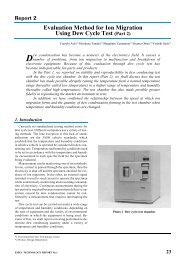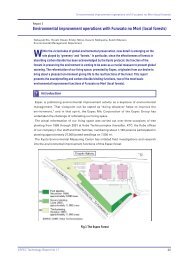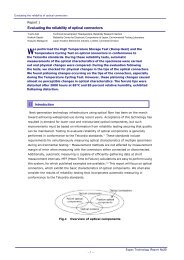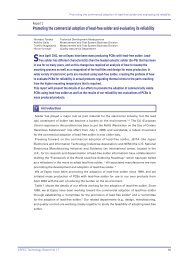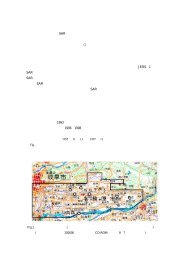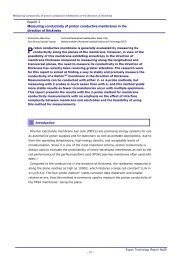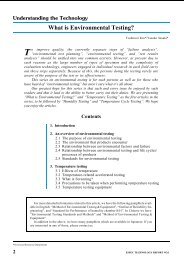Download
Download
Download
You also want an ePaper? Increase the reach of your titles
YUMPU automatically turns print PDFs into web optimized ePapers that Google loves.
5-3-2 How to read MIL standard ID numbers<br />
MIL-STD-883 E 1010.7<br />
(1) (2) (3) (4) (5)<br />
(1) Classification — The following abbreviations are<br />
used.<br />
SPEC: military specification<br />
STD: military standard<br />
HDBK: military handbook<br />
(2) Number of the standard<br />
(3) Alphabetic character indicating the revision<br />
(4) Number of the individual test method<br />
(5) Character indicating the individual test method<br />
revision. Depending on the standard number, this can<br />
be either an alphabetic character or a numeral.<br />
5-3-3 Revisions<br />
A standard generally does not have binding force on its<br />
own, and so merely abolishing an old standard does not<br />
prevent its use. In fact, care must be taken with MIL<br />
standards because old versions are often used. The<br />
following three types of revisions are used.<br />
(1) Amendment<br />
(2) Change Notice<br />
Small-scale revisions are merely issued on an<br />
alteration page. One must realize that details from<br />
previous Change Notices are not included. In this<br />
case, only the test number is revised. (Previous item<br />
(5))<br />
[Example] MIL-STD-883D 1010.6<br />
Example: →MIL-STD-883D 1010.7<br />
(3) Complete revision<br />
Large-scale revisions result in the entire standard<br />
being re-issued. In such cases, the alphabetic<br />
character at the end of the standard number is<br />
changed.<br />
[Example] MIL-STD-883D → MIL-STD-883E<br />
The three instances above are not decoded in the same<br />
way as the JIS standards. The only way to tell the new<br />
versions from the old ones is to compare the texts. Also,<br />
the test method may be revised as in (2) even when the<br />
entire standard is not re-issued as in (3), and so when<br />
investigating MIL standard test methods, you must<br />
confirm the test method number.<br />
5-3-4 Environmental test standards<br />
The following are some typical environmental testing<br />
standards.<br />
MIL-STD-202 Test Methods for Electronic and<br />
Electrical Component<br />
MIL-STD-750 Semiconductor Devices<br />
MIL-STD-810 Environmental Engineering<br />
Considerations and Laboratory Tests<br />
MIL-STD-883 Microcircuit<br />
Tables 5 through 8 show environmental test methods<br />
from within each of the standards.<br />
Table 5 MIL-STD-202F Test Methods for Electronic<br />
and Electrical Component Parts<br />
Class 100 (Environmental Tests)<br />
No. Title<br />
ESPEC TECHNOLOGY REPORT No. 12 7<br />
101<br />
102<br />
103<br />
104<br />
105<br />
106<br />
107<br />
108<br />
109<br />
110<br />
111<br />
112<br />
Salt spray (corrosion)<br />
Temperature cycling<br />
Humidity (steady state)<br />
Immersion<br />
Barometric pressure (reduced)<br />
Moisture resistance<br />
Thermal shock<br />
Life (At elevated ambient temperature)<br />
Explosion<br />
Sand and dust<br />
Flammability (external flame)<br />
Seal<br />
Table 6 MIL-STD-750D Semiconductor Devices<br />
1000 Class Environmental Tests<br />
Method Title<br />
1001 Barometric pressure (reduced)<br />
1011 Immersion<br />
1015 Steady-state primary photocurrent irradiation<br />
procedure (electron beam)<br />
1016 Insulation resistance<br />
1017 Neutron irradiation<br />
1018 Internal water-vapor content<br />
1019 Steady-state total dose irradiation procedure<br />
1020 Electrostatic discharge sensitivity (ESDS)<br />
classification<br />
1021 Moisture resistance<br />
1022 Resistance to solvents<br />
1026 Steady-state-operation life<br />
1027 Steady-state operation life (sample plan)<br />
1031 High-temperature life (nonoperating)<br />
1032 High-temperature (nonoperating) life (sample plan)<br />
1033 Reverse voltage leakage stability<br />
1036 Intermittent operation life<br />
1037 Intermittent operation life (sample plan)<br />
1038 Burn-in (for diodes, rectifiers, and zeners)<br />
1039 Burn-in (for transistors)<br />
1040 Burn-in (for thyristors (controlled rectifiers))<br />
1041 Salt atmosphere (corrosion)<br />
1042 Burn-in and life test for power MOSFET’s or<br />
insulated gate bipolar transistors (IGBT)<br />
1046 Salt spray (corrosion)<br />
1048 Blocking life<br />
1049 Blocking life (sample plan)<br />
1051 Temperature cycling (air to air)<br />
1054 Potted environment stress test<br />
1055 Monitored mission temperature cycle<br />
1056 Thermal shock (liquid to liquid)<br />
1061 Temperature measurement, case and stud<br />
1066 Dew point<br />
1071 Hermetic seal<br />
1080 Single event gate rupture and drain burnout test



